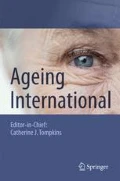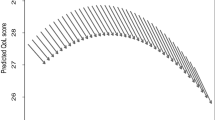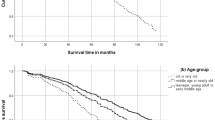Abstract
Psychosocial factors have rarely been examined to determine their influence on longevity in very old adults. The present study evaluated the effect of psychosocial factors, self-rated health and self-rated life expectancy on mortality risk over a nine-year period. A stratified random sample of 2087 males and females aged 65 and older recruited for the Australian Longitudinal Study of Ageing were assessed on measures of perceived control, morale, self-rated health (SRH), social participation, life satisfaction, self-rated life expectancy and self reported physical function. Cox hierarchical regression analyses revealed that for men, perceived control was associated with longevity after controlling for age, SRH and physical function. For women, social participation, morale and perceived control were associated with longevity after controlling for age, SRH and physical function. The effects were of moderate size. Results suggest that social participation and well-being, may account for gender differences in longevity. The impact of positive aspects of psychological functioning, particularly feeling in control, have been under-recognised in gerontological research, which is unfortunate, given their amenability to change or intervention that could result in not only a longer life, but also a more satisfying one.
Similar content being viewed by others
References
Andrews, G.R., Clark, M. & Luszcz, M.A. (in press). Successful Ageing in the Australian Longitudinal Study of Ageing: Applying the MacArthur Model Cross-nationally. Journal of Social Issues.
Anstey, K. J., & Luszcz, M. A. (in press). Mortality risk varies according to gender and change in depressive status in very old adults. Psychosomatic Medicine.
Anstey, K. J., Luszcz, M. A., Giles, L., & Andrews, G. (2001). Demographic, health, cognitive and sensory variables as predictors of mortality in very old adults. Psychology and Aging, 16, 3–11.
Bachman, J.G., O’Malley, P.M., & Johnson, J. (1978). Adolescence to adulthood. Ann Arbor, MI: Institute for Social Research.
Baltes, P.B., Lindenberger, U., & Staudinger, U. (1998). Life-span theory in developmental psychology. In W. Damon (Series Ed.) & R.M. Lerner (Vol. Ed.) Handbook of Child Psychology: Vol 1. Theoretical models of human development (5th ed., pp. 1029–1143). New York: Wiley.
Berg, S. (1996). Aging, behavior and terminal decline. In J. E. Birren, & K. W. Schaie (Eds.), Handbook of the Psychology of Aging (4th Ed.). (pp. 323–336). San Diego: Academic Press.
Berkman, L. F., Syme, S. L. (1979). Social networks, host resistance and mortality: a nine-year follow-up study of Alameda County residents. American Journal of Epidemiology, 109, 186–204.
Cohen, S. & Wills, T. A. (1985). Stress, social support, and the buffering hypothesis. Psychological Bulletin, 98, 310–357.
Fillenbaum, G.G. (1988). Multidimensional Functional Assessment of Older Adults: The Duke Older Americans Resources and Services Procedures. New Jersey: Lawrence Erlbaum.
Idler, E. L., & Benyamini, Y. (1997). Self-rated health and mortality: A review of twenty-seven community studies. Journal of Health and Social Behavior, 38, 21- 37.
Korten, A. E., Jorm, A. F., Jiao, Z., Letenneur, L., Jacomb, P. A., Henderson, A. S., Christensen, H. & Rodgers, B. (1999). Health, cognitive, and psychosocial factors as predictors of mortality in an elderly community sample. Journal of Epidemiology and Community Health, 53, 83–88.
Krause, N., & Shaw, B. A. (2000). Role-specific feelings of control and mortality. Psychology and Aging, 15, 617–626.
Lawton, M. P. (1983). The varieties of wellbeing. Experimental Aging Research, 9, 65–72.
Luszcz, M.A. (1996). Beliefs about control in later life: Implications of perceptions of health, memory and global control. Hong Kong Journal of Gerontology, 10, 502–506.
Luszcz, M. A. (1998). A longitudinal study of ageing in the cognitive and self domains. Australian Developmental and Educational Psychologist, 15, 39–61.
Luszcz, M. A., Bryan, J., & Kent, P. (1997). Predicting episodic memory performance of very old men and women: Contribution from age, depression, activity, cognitive ability and speed. Psychology and Aging, 12, 340–351.
Maier, H., & Smith, J. (1999). Psychological predictors of mortality in old age. Journals of Gerontology: Psychological Sciences, 54B, P44-P54.
Mawby, L., Clark, M.S., Kalucy, E., Hobbin, E.R., & Andrews, G.R. (1996). Determinants of formal service use in an aged population. Australian Journal on Ageing, 15, 177–181.
McCallum, J., Shadbolt, B., & Wang, D. (1994). Self-rated health and survival: A 7-year follow-up study of Australian elderly. American Journal of Public Health, 84, 1100–1105.
Merecz, D., Makowska, Z., & Makowiec-Dabrowska, T. (1999). The assessment of Big Five Personality Factors and Temperament Domains as modifiers of cardiovascular response to occupational stress. International Journal of Occupational Medicine and Environmental Health, 12, 273- 84.
O’Connor, B. P. & Vallerand, R. J. (1998). Psychological adjustment variables as predictors of mortality among nursing home residents. Psychology and Aging, 13, 368–374.
Pinquart, M. (2001). Correlates of subjective health in older adults: a meta-analysis. Psychology and Aging, 16, 414–426.
Reid, D.W., & Ziegler, M. (1980). Validity and stability of a new desired control measure pertaining to psychological adjustment of the elderly. Journal of Gerontology, 35, 395–402.
Rosenberg, M. (1965). Society and the adolescent self-image. Princeton: Princeton University Press.
Rowe, J.W., & Kahn, R.L. (1987). Human aging: Usual and successful. Science, 23, 143–149.
Rowe, J.W., & Kahn, R.L. (1998). Successful aging. New York: Pantheon Books.
Schoevers, R. A., Geerlings, M. I., Beekman, A.T., Penninx, B.W., Deeg, D.J., Jonker, C., Van Tilburg, W. (2000). Association of depression and gender with mortality in old age. Results from the Amsterdam Study of the Elderly (AMSTEL). British Journal of Psychiatry, 177, 336–42.
Schulz, R., Beach, S. R., Ives, D. G., Martire, L. M., Ariyo, A. A., Kop, W.J. (2000). Association between depression and mortality in older adults: the Cardiovascular Health Study. Archives of Internal Medicine, 160, 1761–8.
Small, B. J., & Bäckman, L. (1997). Cognitive correlates of mortality: Evidence from a population-based sample of very old adults. Psychology and Aging, 12, 309–313.
Shapiro, D. H., Lindberg, J., Daniels, J. M., Breuer, A. M. & Astin, J. (1994). Assessing the relationship between a multidimensional psychological “control profile” and cardiovascular risk. International Journal of Psychosomatics, 41, 11–6.
Thoits, P. (1995). Stress, coping and social support processes: Where are we? What next? Journal of Health and Social Behavior, 36, 53–79.
Wulsin, L. R., Vaillant G. E., Wells V. E. (1999). A systematic review of the mortality of depression. Psychosomatic Medicine, 61, 6–17.
Van Doorn, C., & Kasl, S.V. (1998). Can parental longevity and self-rated life expectancy predict mortality among older persons? Results from an Australian Cohort. Journal of Gerontology: Social Sciences, 53B, S28-S34.
Yang, E. V., & Glaser, R. (2000). Stress induced immunomodulation: impact on immune defenses against infectious disease. Biomedicine & Pharmacotherapy, 54, 245- 50.
Author information
Authors and Affiliations
Additional information
Kaarin Anstey is a Fellow at the Centre for Mental Health at the Australian National University and works on longitudinal epidemiological studies of aging and mental health. She has published extensively in the field of gerontology, focussing on predictors of cognitive decline, psychological predictors of mortality and biomarkers of aging. Centre for Mental Health Research, Australian National University, School of Psychology, Flinders University, Centre for Ageing Studies, Flinders University.
Mary Luszcz is Professor of Psychology at Flinders University, Editor of the Behavorial Sciences Section of Gerontology and former Secretary General and Vice President of the International Association of Gerontology (IAG). She has published widely in the field of cognitive aging and has specific interests in memory aging, gender, and wellbeing.
Gary Andrews is the immediate Past-President of the IAG, Honorary Professor and Director of the Centre for Ageing Studies, Flinders University of South Australia. He is a principal investigator of the ALSA, and has also been responsible for a series of studies of health and social aspects of aging in more than 16 countries in Asia, the Pacific and in the Middle East under WHO auspices.
Rights and permissions
About this article
Cite this article
Anstey, K.J., Luszcz, M.A. & Andrews, G. Psychosocial factors, gender and late-life mortality. Ageing Int. 27, 73–89 (2002). https://doi.org/10.1007/s12126-002-1003-3
Accepted:
Issue Date:
DOI: https://doi.org/10.1007/s12126-002-1003-3




